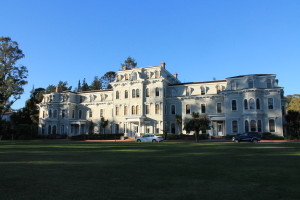Patrons wait in line for the Chinese music performance in the lobby of the Oakland Asian Cultural Center, excitement spoken in several languages. After the announcer opens the show and introduces the first musical piece in both Chinese and English, a warm light fades in to shine on the instruments. As the audience quiets, the ensemble begins to play music that evokes echoes of universal feelings and long histories, as the notes dance alongside the players.
On Oct. 1, Strings of China marked the first collaboration between Tranquil Resonance Studio (TRS) and China Spirit Music Ensemble (CSME). Tranquil Resonance Studio is dedicated to teaching and sharing classical Chinese arts, including lessons in the guzheng (Chinese table harp), guqin (seven string zither), and the erhu (Chinese two-string fiddle), whereas CSME is focused solely on the guzheng.

The nine songs differed in instruments and style, but almost all of them were related to nature or autumn in some way. Before each performance, the announcer shared the stories and histories behind the musical pieces. One song Flowing Water was from a duet called High Mountain Flowing Water, and was performed by Lee and David Wong, Artistic director and Executive director from Tranquil Resonance.
Many of the pieces performed, like Flowing Water, are classics that date back to the Chinese dynasties. Other songs performed that night were written in the 1920s and 30s.
TRS Programs Director Alan Yip focuses on preserving and building upon the rich history of China through his teaching and playing of ancient Chinese instruments. He wants to balance the traditional mindset of forming a relationship with the music, and taking music in stride with modern times. He feels the program reflects this idea of highlighting both traditional and more contemporary Chinese pieces, especially when it came to the guzheng arrangements. Yip hopes that the organizations will continue to expand the event in the future.
“The most important thing about being here in the U.S. is to keep as much of that identity as possible,” Yip said. “I think more opportunities need to be available to the public…there needs to be a dialogue.”
CSME’s director, Winnie Wong, arranged the guzheng section for four pieces out of the nine in the program. Yip thought she was able to take old historical songs and arrange the guzheng ensembles in a way that uses traditional foundations to create striking new combinations. Even having a guzheng ensemble is unusual, Yip noted, as the instrument is most commonly played solo or accompanied by other instruments. In addition, Winnie Wong and pianist Donna Stoering performed the Lament of the Rainbow Cloud together, a guzheng and piano duet, something not commonly done.

Mills Chinese Professor Chiu-Hung Chen attended the performance and found the pieces pleasantly surprising. She thought that the program would include more traditional pieces, instead finding the new arrangements well-executed. In Lament of the Rainbow Cloud, the instrument combination struck her.
“I never heard that kind of combination. I feel like they are talking to each other,” Chen said. “They compliment each other pretty well.”
Yip believes that music is closely tied to language. He can hear that the northern style of guzheng in Henan has a distinct voice.
“Henan is a place where the music reflects the dialect,” Yip said.
Jared Young, a biology professor at Mills, originally attended the performance with his two daughters because one of his students was performing. He walked out feeling more connected to the rich culture of China, calling the experience “transformative.”
As a parent, this event was also something that he wanted to share with his kids.
“I did have an awareness that this was an opportunity to expose them to an important part of their heritage,” Young said. “I feel like I left with a much greater appreciation of the music and it helped me connect with Chinese culture in a pretty deep way.”



